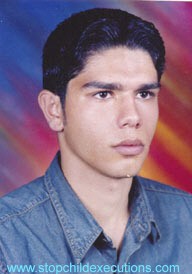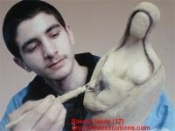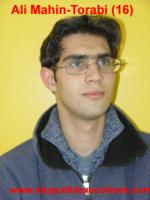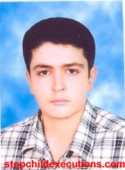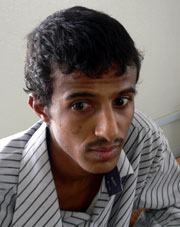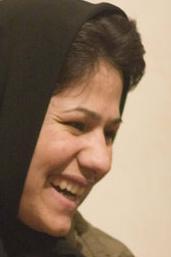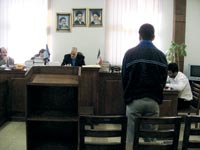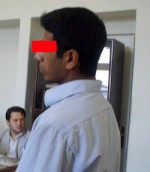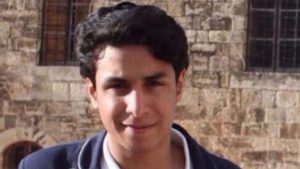
|
|
Released Hossein ToranjHossein Toranj was implicated in a fight that broke out between several boys in Shahrakeh Gharb in August 2003, when he was 17 years old. He claims that he came to his little brother’s defence from a man named Morteza in possession of a knife, and he said he threw knives towards Morteza twice to ward him away. He said he did not intend to kill anyone, rather he just wanted to scare off his attacker. Hossein’s mother spoke with Morteza’s family and managed to obtain a pardon from them, and he has now been released from prison. More information:
|
|
|
|
Pardoned Reza Alinejad was sentenced to death for a murder he says he committed in self-defence when he was 17 years old. The incident happened on 26 December 2002 in a street in Fasa, a city near Shiraz in Central Iran. Reza and his friend was sitting on the sidewalk when they were approached by two men, Esmail Daroudi and Mohammad Firouzi, who started harassing them and then proceeded to attack Reza and his friend with a nunchaku (a Japanese weapon used in martial arts). Reza Alinejad says that he pulled out a pocket knife during the struggle and accidentally stabbed and killed one of the men. In December 2004 the Supreme Court rejected the death sentence, accepting that Reza Alinejad had acted in self-defence. The Supreme Court sent the case back to another lower court for investigation, where he on 15 June 2005 was sentenced to death again.On 9 May 2006, the Supreme Court upheld the death sentence. Reza was released on 3 December 2008 after his family had paid diyeh (blood money) to the family of the victim. They had to mortgage their home and borrow a large sum of money at a high interest rate to secure the monye. The amount paid has not been disclosed. Reza maintains his innocence and says that the death was as a result of defending himself against the attackers. More information: |
|
|
|
Pardoned Saeed JazeeSaeed Jazee was imprisoned for murder in 2003 at the age of 17 and was pardoned in July 2008. According to Saeed’s explaination he was a sculpturing artist who went to the sandwich shop of his close friend to eat while his family were on vacation. He picked a sandwich and started eating and the new employee, Morteza Jaan-Zamin, who did not know Saeed started arguing, took the kitchen knife and attacked Saeed . Saeed resisted and the knife fell and Saeed in order to scare and stop the employee picked up the knife, but the employee charged towards him while Saeed was holding the knife. After being injured, Saeed tried to help and even other employees who had seen the incident hid the knife since they felt that Saeed was not at fault. At July 24, 2008 in a memorial ceremony named Khoon Bas (Enough Blood), the parents of the victim officially pardoned Saeed. In return they have received Dieh (Blood Money) however the amount of retribution has not been disclosed. More information:
|
|
|
|
Pardoned Ali Mahin TorabiAli Mahin Torabi was sentenced for murdering another youth, Mazdak Khodadadian, during an argument in Bani Hashemi High School in February 2003. He was 16 years old at the time. According to Ali’s testimony, he did not know Mazdak had been stabbed until he heard shouting from the crowd that had gathered around them. A Juvenile Court in Karaj sentenced Ali Mohin Torabi to qesas on 30 October 2003 and on 8 June 2004, Branch 27 of the Supreme Court upheld the sentence. In July 2008 Ali’s death sentence was overturned by Iran’s head of judiciary, Ayatollah Shahrudi. More information: |
|
|
|
Free Mohammad Latif Mohammad Latif was sentenced to death for killing an 18 year old boy named Mansour Kayaee, at the age of 14. According to his father, Mohammad was attacked by Mansour and accidentally killed him while trying to take the knife away from him. In early December, the file of Mohammad Latif was sent to Ayatollah Shahrudi, Iran’s head of judiciary for final approval before execution.At February 22, 2008, Mohammad Latif was released from Saveh prison in Iran. Faced with international pressure, Ayatollah Shahroudi sent the file back for mediation between the families of the victim and Mohammad where he was ultimately pardoned. When Mohammad Latif was released from prison he went to the cemetery and cried on Mansour’s grave asking for forgiveness. After 3 years in prison and facing execution, the 18-year-old Mohammad said that the victim never left his mind. Although he was in a state of shock when he was released he said, “I never intended to kill him and that is why I felt like I will not be executed. When asked about his opinion of the legal process of his file, he replied: “I was not happy with it. The death sentence was unjust”. More information: |
|
|
|
Pardoned MohsenA child offender named Mohsen sitting on the execution row , was pardoned by the victim’s family on Christmas day 2007 at the age of 18. Mohsen was accused of killing his brother’s friend 3 years ago , at the age of 15, during a soccer game after the alleged victim and his younger brother get in to a fight. He was consequently sentenced to death by hanging. The verdict was approved by Iran’s superior court but the file was sent to the mediation committee which resulted in pardon by victim’s family on December 25, 2007. Source: |
|
|
|
Free Sina PaymardSina Paymard, a musician, was convicted of murder after a dispute with a man over cannabis in 2004. Sina Paymard reportedly told the Court that he was addicted to drugs and had gone to a park in Tehran on the day of the incident to try and obtain cannabis from a drug dealer. He allegedly stabbed the drug dealer to death during a fight. Sina’s death sentence was overturned after his family and private donors managed to collect and pay $ 160000 in blood money to the family of the victim. On December 24, 2007 Sina was released after spending 3 1/2 years in prison. |
|
|
|
Free Hafez Ibrahim (male – 16): YemenHafez Ibrahim was sentenced to death in 2005 for a murder he allegedly committed when he was 16. His execution was originaly scheduled to take place on April 6, 2005, however, the Minister of Human Rights intervened and personally appealed to the president to stay the execution. She then tried to get the death sentence commuted, by obtaining a pardon from the family of the murder victim. The president stayed the execution to allow time for an agreement to be reached. Following the August 2007 report by Amnesty International and Stop Child Executions Campaign and a letter to the leaders of the Republic of Yemen by Nazanin Afshin-Jam and many other international pleas, the alleged victim’s family agreed to a stay of execution until after the Muslim fasting month of Ramadan, which ended in mid-October. Hafez Ibrahim was released on 30 October after the family of the man he was convicted of murdering agreed to pardon him in exchange for diyeh (compensation) of 25 million Yemeni riyals (approximately USD$126,217). More information: |
|
|
|
Free Nazanin FatehiAfter spending two grueling years in prison, Nazanin Fatehi was spared from her original death sentence, released from prison and reunited with her family on Janurary 31st 2007. On January 3, 2006, Nazanin Mahabad Fatehi was sentenced to death for murder by court in Iran after she stabbed one of three men who attempted to rape her and her 15-year-old niece in a park in Karaj (a suburb of Tehran) in March 2005. She was seventeen years old at the time. Iran is signatory to international treaties, which forbid them to execute anyone under the age of 18; however they continue to do so. The injustice of this case propelled Nazanin Afshin-Jam to take immediate action and start a petition to help save the life of her namesake. With many speeches and rallies worldwide and months on the media circuit, over 345,000 signatures were collected and delivered to the United Nations and Iranian Officials. Nazanin and Mina Ahadi, the head of the International Committee Against Execution, managed to engage Amnesty International, Canadian Members of Parliament, the European Union and the United Nations and others to put pressure on the Iranian Officials to spare the life of this child. Nazanin also hosted a compelling documentary entitled “The Tale of Two Nazanins,” funded and produced by the Calvin Ayre Foundation. Following pressure from the International community, on June 1st 2006, the Head of Judiciary Ayatollah Shahroudi announced a stay of execution and the call for a complete new retrial. During the new trial on January 10, 2007, the five judges presiding over the case found inconsistencies with the testimonies of the male witnesses and unanimously ruled out premeditated murder and determined that the act was a case of self-defense. As a result Nazanin Fatehi was exonerated from the charge of murder. While two judges wanted her to be freed unconditionally, three of the judges ruled that disproportionate force was used and requested her to pay “diyeh” (blood money) to compensate the family of the deceased. Fatehi’s lawyers Shadi Sadr and Mr. Mostafaei vehemently oppose this payment and have since appealed, but in order for there not to be any delays or additional time served, Nazanin was given the option to pay a set bail of 400,000,000 Rials (approx US$43,000). The Fatehi family, which includes six children, is extremely poor and was unable to meet this payment. Thanks to $32,000 USD in on-line donations to the Nazanin Fatehi Trust Fund here at www.helpnazanin.com, $1,000 USD collected in Iran and an extremely generous donation by Member of Canadian Parliament Belinda Stronach who covered the rest of the bail, payment was made to the courts in Iran. A few days later, Nazanin was released from prison and had an emotional reunion with her family. While she could hardly speak and in tears of happiness, she said: “The only thing I can say now is that I am extremely happy. It is as if I am born again. I want to thank everyone who helped make my freedom possible and I want to say that I love you all from the bottom of my heart”.
|
|
|
|
Free Mohammad (15) Sentenced to death at 15 Free at age 18 in February 2007 (parents of victim forgave him)Source: Etemmad newspaper February 2007 http://www.etemaad.com/Released/85-11-17/97.htm |
|
|
|
Free LEYLA MAFI (15)According to a Tehran newspaper from the 28 november 2004, Leyla Mafi, now aged 20 (beginning of year 2007, though her real age differ according to the different sources), but having, according to repeated tests of social workers, a mental age of height, was forced into prostitution by her mother when she was only 8 years old, and afterwards was raped repeatedly. At the age of 9 she gave birth to her first child and was sentenced to 100 lashes for prostitution. She was sold by her familly as a “temporary wife” to an Afghan man at the age of 12, and was sentenced to a further 100 lashes after having become pregnant again at the age of 14. She then was moved to a maternity ward to give birth to twins, but her familly sold her again to another man, aged 55 and married with two children, who got Leyla’s customers come in his house. She was sentenced to death by a court in Arak (240 south-west of Tehran) while she was 18, but for “offences” committed before this age. According to the 5 may 2004 issue of the daily newspaper Khorasan, the charges against her where “acts contrary to chastity” (a’mal-e khalaf-e ‘ofat), controlling a brothel, having intercourse with blood relatives (eteham-e zena ba maharem) and giving birth to an illegitimate child. The sentence was, apparently, based on their own confessions. We must also note, according to the SAFIR (Franco-Iranian Jurists and Lawyers Society), 28 february 2005, that no independant evaluation of the age and of the mental abilities of Leyla Mafi had been conducted. In October 2005, after a campaign run by human rights activists, based on the fact that she was a minor at the time of her “offences”, her death sentence was overturned by the presiding judge of Branch 104 of the General Court of Arak, who nevertheless sentenced her to receive 99 lashes, to three-and-a-half years’ imprisonment and to reside for six months in a women’s rehabilitation centre. According to the Norwegian daily newspaper Aftenposten, 10 january 2007, she now lives in a private learning center called Omide Mehr in Tehran, where she is protected from her family if they should come after her again. She has learned to read and write, cook and mend clothes, and she has gotten the will to live back again. Sources: Press releases, Norwegian: Report of the Société des Avocats et Juristes Franco-Iraniens, French: |


